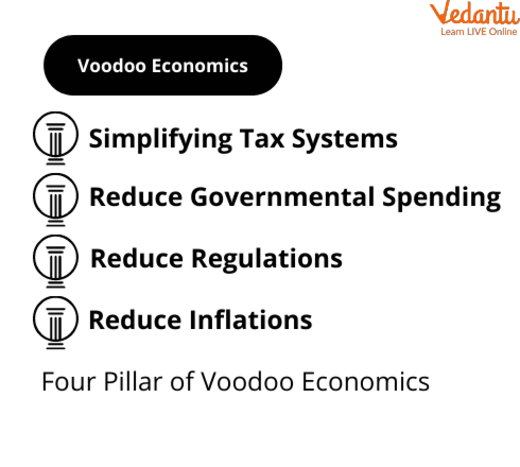




Voodoo Economics: An Introduction
Before becoming his vice president, George H.W. Bush referred to Ronald Reagan's economic policies as "voodoo economics." Bush coined the remark, which was deemed derogatory, in 1980. Reagan's supply-side policies, he feared, would not only fail to revive the economy but would also greatly increase the nation's national debt.
Reagan employed voodoo economics, often known as "Reaganomics," to help improve the economy after years of stagnation after former President Jimmy Carter's administration. Today, the term "voodoo economics" is commonly used to criticise any overly ambitious political program.

Voodoo Economics
Voodoo Meaning: What Does this Actually Mean?
George H. W. Bush popularised the term "voodoo economics," a disparaging term used to describe President Ronald Reagan's economic policy of cutting government expenditure, boosting income and capital gains taxes, and regulating the market's money supply to reduce inflation and increase the nation's economy.
The strategy's key goals were to encourage individuals to invest and save money by lowering inflation, simplifying taxation, eliminating regulations, and cutting government spending. Following its implementation, this initiative was successful in raising the US GDP and creating job opportunities, both of which resulted in improved economic conditions.
History of Voodoo Economics
President Ronald Reagan's economic theories, popularly known as "Reaganomics," were mocked by George H.W. Bush as "voodoo economics."
Let’s go through Voodoo history now. Before being appointed as Reagan's vice president in 1980, Bush Sr. cautioned that the president's supply-side measures would not be enough to recover the economy and would greatly increase the national debt.
Bush Sr. was chastised for insulting his political rival at the time, but his allegation that Reaganomics is voodoo economics has stood the test of time.
Since then, the term "voodoo economics" has gained currency as a derogatory word for politicians' bold economic claims.

Pillars of Voodoo Economics
Reaganomics, sometimes known as voodoo economics, first appeared in 1981. There were four major objectives to achieve:
Lowering inflation by limiting the money supply
Tax cuts on income and capital gains
Reducing government spending
A reduction in regulation
The core idea of Reaganomics was that if people were encouraged to spend and invest more, the economy would improve dramatically. The four Reaganomics pillars were created to keep financial markets stable and to encourage entrepreneurial endeavours.
Criticism of Voodoo Economics
Reagan's economic measures were widely acknowledged to be broad. The issue is that the reforms' premise was completely different from what actually happened when they were implemented.
Reagan, for example, set out to drastically reduce government spending. He refrained from removing any federal or state programmes because of fear of a strong popular backlash. Despite a 1.5% decline in overall spending growth during the Carter administration, the nation's defence budget soared to previously unheard-of levels. It prevented Reagan's projected large cut in government spending.
Another feature of Reaganomics that garnered heavy criticism was its emphasis on deregulation, which was based on the notion that the government should only intervene with the free market if it was absolutely necessary.
Case Study
How has the Industry Changed from Voodoo Economics to Evil-Eye Economics?
Nearly 40 years ago, while running for president, George H.W. Bush referred to Ronald Reagan's claim that decreasing taxes on the wealthy would pay for itself as "voodoo economic policy." He's not as foresighted as he believed. After all, voodoo economics is more than just a mystical philosophy. It's the ultimate policy zombie—a conviction that defies rational thought. Every attempt by its backers to put it into action has failed, yet it continues to sputter. It has now consumed the minds of all important Republican Party figures. Susan Collins, the most conservative Republican senator, contended that the 2017 tax cut would actually reduce the deficit.
This is more than voodoo economics, so we should name it evil-eye economics. To be fair, Trump's claim that Democrats are casting a spell on his success is simply a minor point in his tirade. He has chastised chiefly the Fed for its "crazy" interest rate hikes. And the truth is that the rate increases from last year were clearly a mistake.
Conclusion
Reagan's economic policies were most successful in terms of increasing the American economy. The country's Gross Domestic Product (GDP) and stock market both surged at breakneck speeds while inflation fell drastically. Furthermore, the government subsequently received much more overall tax revenue as a result of his tax cuts due to economic development.
FAQs on Voodoo Economics
1. What are the pillars of Voodoo Economics?
The following were the four pillars of Voodoo economics:
Tax System Simplification
Reduce government spending.
Reduce the regulations
Reduced Inflation
The US tax system was simplified by lowering the top income tax rate from 70% to 28% and the corporate tax rate from 48% to 34% using voodoo economics. Furthermore, by modifying the standards for low-income and disadvantaged people to acquire exemptions, boosting the excise duty rate, and eliminating income deductions, people began saving and investing more as a result of reduced tax rates. As a result, the money supply in the market improved, economic conditions improved, and people's quality of living improved, increasing the country's GDP.
2. Why Is Voodoo Economics Important?
According to numerous estimates, Reaganomics bolstered the country's struggling economy. During the Carter administration, for example, manufacturing productivity climbed at a record 3.8%, and the rate of growth in real GDP per working-age adult more than doubled. In only eight years, the rate of new business formation soared, the unemployment rate fell from 7% to 5.4%, inflation fell from 10.4% to 4.2%, and the stock market boomed.
Voodoo economics showed that decreasing tax rates might, in reality, increase or at least sustain the government's revenue for social programmes and discretionary spending by encouraging people to invest, spend, and establish businesses with their own money, increasing the amount of taxable income. Reagan's economic theory has become one of the most well-known and divisive in modern American history. Reagan's goal was to cut taxes and then "make it up in volume."
3. Explain the significance of Voodoo Economics.
The program, which began in 1981 and was infamously dubbed "voodoo economics" by George H.W. Bush (before becoming Reagan's vice president), had four goals: lower taxes on income and capital gains, less regulation, slower growth in government spending, and lower inflation by reducing the money supply. The economy was supposed to be enhanced by motivating individuals to spend and invest, ensuring the stability of financial markets, and rewarding entrepreneurialism.
Another significant part of voodoo economics was deregulation, which stemmed from the belief that the government should only intervene in free enterprise when absolutely necessary.





















